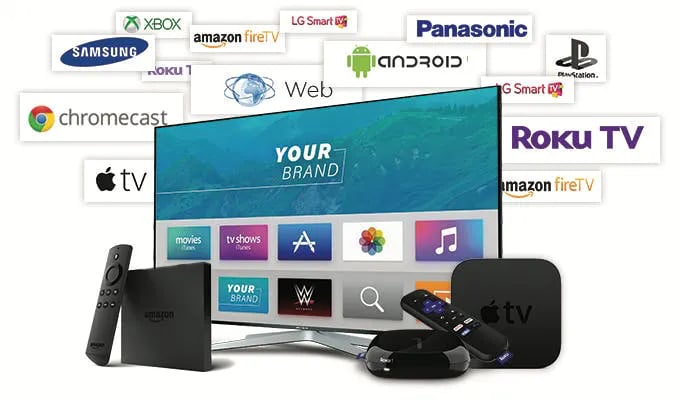
Just Released! OTT and Beyond — The Ultimate Guide for Your OTT Service is the perfect asset to guide you through the process of launching and scaling your on-demand or live video business into an OTT service. Get it now.
But which OTT platform is best for YOU? It seems like there’s a new OTT streaming device on the market every day. As new devices become available and carve out their own slice of market share, content owners are drowning in options. How can anyone decide where to invest their time, content, and money?
It's not just about development and distribution
The Big 3 OTT Platforms we chose to highlight all currently have options or are most likely to have options soon that will allow content owners to make their OTT investment worthwhile.
But investing in a video app for OTT requires more than just great content and efficient tools to build, operate, and measure. Your investment requires marketing, promotion, and a device audience that fits.
How do you decide WHERE to distribute your content? What's the evaluation criteria for selecting one OTT device or platform over another?
We're glad you asked.
The 5 OTT platform characteristics that content owners should care about
We identified five characteristics that content owners should care about when selecting where to distribute their content:
![]()
1. Consumer Ease of Use
Is the OTT platform, from the device itself to the software it runs, a great and easy experience for the typical consumer? It better be. Ideal OTT platforms should be accessible to anyone, including those with limited tech expertise, simple enough for the consumer to perform all desired functions and tasks, and allow people to easily find any content they want.
![]()
2. Discovery
Discovering new content quickly is paramount. Does the platform have the ability for new audiences to discover new content as well as opportunities available for content owners to harness that power?
What opportunities do content owners have to enable new fans to organically discover their content? What paid promotional opportunities are available within the platform?
![]()
3. Ability to Execute
The Gartner Magic Quadrant criteria for evaluating a product’s ability to execute includes: Product/Service, Overall Viability, Sales, Execution/Pricing, Market Responsiveness and Track Record, Marketing Execution, Customer Experience, and Operations.
For OTT, “Ability to Execute” refers to the ease of developing a channel, robustness of channel design options, the channel submission process, working with the marketplace, and getting approval from the platform to push the channel live.
![]()
4. Audience Reach and Ecosystem
Many factors need to align for true OTT success. What are OTT demographics? Is your content's target audience the same audience that uses the device? What is the market share and popularity of the device? Each OTT device is unique and has its own appeal to a certain subset of the population.
Of course, video business owners want to reach as many viewers as possible, and since each device caters to a different segment of the population, using all three top OTT platforms is the ideal way to do that.
![]()
5. Monetization Capabilities
There are multiple monetization pathways content owners can take including advertising, subscription, purchase, rental, or a hybrid monetization model that incorporates two or more of these monetization methods.
There’s also a distinction between native and universal models.
Native subscription models (Native SVOD) go through the device itself. For example, in order to watch content on Roku, a native subscription model would require that viewers have a Roku account. Any content paid for via Roku native SVOD would be charged via Roku to the user’s credit card on file and subject to a percentage fee paid to the platform.
Universal subscription models (Universal SVOD) require a unique PIN for the content, and is accessible through any device; Netflix is a great example of a universal subscription service.
Make sure you consider the device’s ability to support different monetization models and if it’s in accordance with what you need for your video business.
When deciding to put your content on an OTT device, or especially if you want to have multiple branded apps across multiple destinations, it’s important to work with an OTT distribution platform that gives you the ability to streamline your video business. You should have the ability to seamlessly publish your content cross-platform without the time-consuming need to re-work and edit your entire video library each time you distribute to a new destination.
Wondering which are the Big 3 OTT Platforms you should focus on? Stay tuned for Parts 2, 3, and 4 to find out!